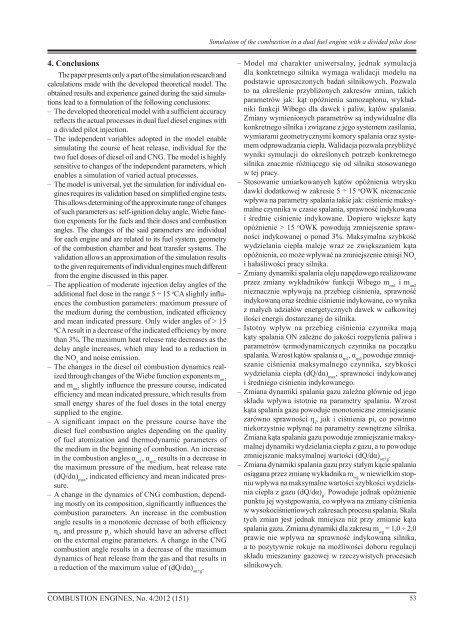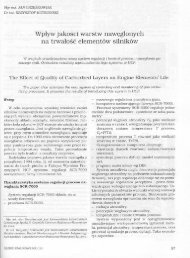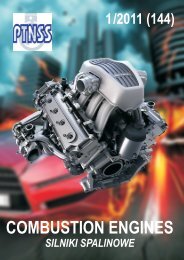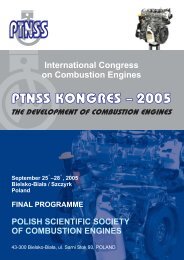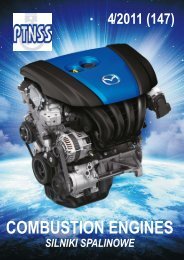Create successful ePaper yourself
Turn your PDF publications into a flip-book with our unique Google optimized e-Paper software.
Simulation of the combustion in a dual fuel engine with a divided pilot dose<br />
4. Conclusions<br />
The paper presents only a part of the simulation research and<br />
calculations made with the developed theoretical model. The<br />
obtained results and experience gained during the said simulations<br />
lead to a formulation of the following conclusions:<br />
– The developed theoretical model with a sufficient accuracy<br />
reflects the actual processes in dual fuel diesel engines with<br />
a divided pilot injection.<br />
– The independent variables adopted in the model enable<br />
simulating the course of heat release, individual for the<br />
two fuel doses of diesel oil and CNG. The model is highly<br />
sensitive to changes of the independent parameters, which<br />
enables a simulation of varied actual processes.<br />
– The model is universal, yet the simulation for individual engines<br />
requires its validation based on simplified engine tests.<br />
This allows determining of the approximate range of changes<br />
of such parameters as: self-ignition delay angle, Wiebe function<br />
exponents for the fuels and their doses and combustion<br />
angles. The changes of the said parameters are individual<br />
for each engine and are related to its fuel system, geometry<br />
of the combustion chamber and heat transfer systems. The<br />
validation allows an approximation of the simulation results<br />
to the given requirements of individual engines much different<br />
from the engine discussed in this paper.<br />
– The application of moderate injection delay angles of the<br />
additional fuel dose in the range 5 ÷ 15 o CA slightly influences<br />
the combustion parameters: maximum pressure of<br />
the medium during the combustion, indicated efficiency<br />
and mean indicated pressure. Only wider angles of > 15<br />
o<br />
CA result in a decrease of the indicated efficiency by more<br />
than 3%. The maximum heat release rate decreases as the<br />
delay angle increases, which may lead to a reduction in<br />
the NO x<br />
and noise emission.<br />
– The changes in the diesel oil combustion dynamics realized<br />
through changes of the Wiebe function exponents m on1<br />
and m on2<br />
slightly influence the pressure course, indicated<br />
efficiency and mean indicated pressure, which results from<br />
small energy shares of the fuel doses in the total energy<br />
supplied to the engine.<br />
– A significant impact on the pressure course have the<br />
diesel fuel combustion angles depending on the quality<br />
of fuel atomization and thermodynamic parameters of<br />
the medium in the beginning of combustion. An increase<br />
in the combustion angles α sp1<br />
, α sp2<br />
results in a decrease in<br />
the maximum pressure of the medium, heat release rate<br />
(dQ/dα) max<br />
, indicated efficiency and mean indicated pressure.<br />
– A change in the dynamics of CNG combustion, depending<br />
mostly on its composition, significantly influences the<br />
combustion parameters. An increase in the combustion<br />
angle results in a monotonic decrease of both efficiency<br />
η i<br />
, and pressure p i<br />
, which should have an adverse effect<br />
on the external engine parameters. A change in the CNG<br />
combustion angle results in a decrease of the maximum<br />
dynamics of heat release from the gas and that results in<br />
a reduction of the maximum value of (dQ/dα) on+g<br />
.<br />
– Model ma charakter uniwersalny, jednak symulacja<br />
dla konkretnego silnika wymaga walidacji modelu na<br />
podstawie uproszczonych badań silnikowych. Pozwala<br />
to na określenie przybliżonych zakresów zmian, takich<br />
parametrów jak: kąt opóźnienia samozapłonu, wykładniki<br />
funkcji Wibego dla dawek i paliw, kątów spalania.<br />
Zmiany wymienionych parametrów są indywidualne dla<br />
konkretnego silnika i związane z jego systemem zasilania,<br />
wymiarami geometrycznymi komory spalania oraz systemem<br />
odprowadzania ciepła. Walidacja pozwala przybliżyć<br />
wyniki symulacji do określonych potrzeb konkretnego<br />
silnika znacznie różniącego się od silnika stosowanego<br />
w tej pracy.<br />
– Stosowanie umiarkowanych kątów opóźnienia wtrysku<br />
dawki dodatkowej w zakresie 5 ÷ 15 o OWK nieznacznie<br />
wpływa na parametry spalania takie jak: ciśnienie maksymalne<br />
czynnika w czasie spalania, sprawność indykowana<br />
i średnie ciśnienie indykowane. Dopiero większe kąty<br />
opóźnienie > 15 o OWK powodują zmniejszenie sprawności<br />
indykowanej o ponad 3%. Maksymalna szybkość<br />
wydzielania ciepła maleje wraz ze zwiększaniem kąta<br />
opóźnienia, co może wpływać na zmniejszenie emisji NO x<br />
i hałaśliwości pracy silnika.<br />
– Zmiany dynamiki spalania oleju napędowego realizowane<br />
przez zmiany wykładników funkcji Wibego m on1<br />
i m on2<br />
nieznacznie wpływają na przebieg ciśnienia, sprawność<br />
indykowaną oraz średnie ciśnienie indykowane, co wynika<br />
z małych udziałów energetycznych dawek w całkowitej<br />
ilości energii dostarczanej do silnika.<br />
– Istotny wpływ na przebieg ciśnienia czynnika mają<br />
kąty spalania ON zależne do jakości rozpylenia paliwa i<br />
parametrów termodynamicznych czynnika na początku<br />
spalania. Wzrost kątów spalania α sp1<br />
, α sp2<br />
powoduje zmniejszanie<br />
ciśnienia maksymalnego czynnika, szybkości<br />
wydzielania ciepła (dQ/dα) max<br />
, sprawności indykowanej<br />
i średniego ciśnienia indykowanego.<br />
– Zmiana dynamiki spalania gazu zależna głównie od jego<br />
składu wpływa istotnie na parametry spalania. Wzrost<br />
kąta spalania gazu powoduje monotoniczne zmniejszanie<br />
zarówno sprawności η i<br />
, jak i ciśnienia pi, co powinno<br />
niekorzystnie wpłynąć na parametry zewnętrzne silnika.<br />
Zmiana kąta spalania gazu powoduje zmniejszanie maksymalnej<br />
dynamiki wydzielania ciepła z gazu, a to powoduje<br />
zmniejszanie maksymalnej wartości (dQ/dα) on+g<br />
.<br />
– Zmiana dynamiki spalania gazu przy stałym kącie spalania<br />
osiągana przez zmianę wykładnika m wg<br />
w niewielkim stopniu<br />
wpływa na maksymalne wartości szybkości wydzielania<br />
ciepła z gazu (dQ/dα) g<br />
. Powoduje jednak opóźnienie<br />
punktu jej występowania, co wpływa na zmiany ciśnienia<br />
w wysokociśnieniowych zakresach procesu spalania. Skala<br />
tych zmian jest jednak mniejsza niż przy zmianie kąta<br />
spalania gazu. Zmiana dynamiki dla zakresu m wg<br />
= 1,0 ÷ 2,0<br />
prawie nie wpływa na sprawność indykowaną silnika,<br />
a to pozytywnie rokuje na możliwości doboru regulacji<br />
składu mieszaniny gazowej w rzeczywistych procesach<br />
silnikowych.<br />
<strong>COMBUSTION</strong> <strong>ENGINES</strong>, No. 4/2012 (151)<br />
53


